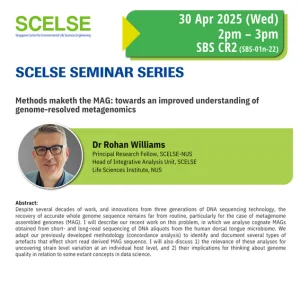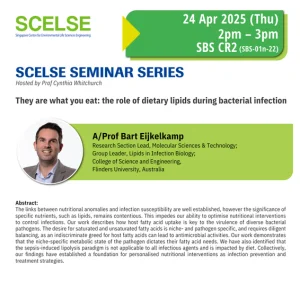Host-virus conflicts in halophilic archaea
Time: 1pm – 2pm
Venue: NTU School of Biological Sciences CR3 (SBS-01n-23)
Many CBASS Systems defend against viral infections by a TIR-SAVED domain protein that depletes cellular NAD+ levels, eventually leading to cell dormancy or death. Such abortive infection strategy is beneficial in stopping a fast lytic infection because cells die before spreading the virus to sister cells. Conversely, many archaea are infected by chronic “temperate” viruses that co-exist with their hosts for extended periods. Under such situations, abortive infection could be deleterious, because the cost of immunity may be higher than that of infection. Here we study an archaeal Type II-C CBASS System from Haloferax strain Atlit 48N, which we heterologously expressed in the model organism Haloferax volcanii DS2. We show that the system protects against a chronically-infecting virus, HFPV-1, and enables clearing of that virus after several passages, without killing the host. Furthermore, cells that cleared the virus become much more resistant to future infection by HFPV-1, without acquisition of CRISPR spacers from that virus. Cell death during viral infection only occurs after extensive incubation in the presence of HFPV-1. This suggests that CBASS systems could be beneficial even for archaea that are exposed to chronic infecting viruses, and could explain why such systems are relatively common in archaea. Mechanistic aspects of the system will also be discussed.
Speaker:
Professor Uri Gophna
The Shmunis School of Biomedicine and Cancer Research, Tel Aviv University
Biography:
The Gophna lab studies two main areas using computational and experimental approaches: the microbiome in inflammatory bowel disease (IBD) microbiome and viruses/phages and how viruses and anti-viral defenses affect horizontal gene transfer. In IBD the lab made significant discoveries about pouchitis treatment, showing that antibiotics work by selecting for less inflammatory bacteria rather than reducing bacterial load. The lab also demonstrated distinct evolutionary adaptations in IBD-associated E. coli strains. Their research revealed that bacterial strains in different parts of the intestine evolve through purifying selection from common founder strains. In their virus/phage work, the lab discovered new interactions between “cheater phages” and led an international project that identified new groups of environmental RNA viruses and previously unknown anti-defense systems in RNA viruses, before moving on to study chronic viral infections in archaea, and the role that defense systems play. He is an elected member of both the European and American academies of microbiology, as well as EMBO.





